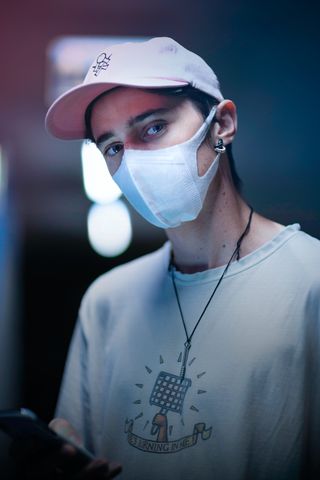Coronavirus Disease 2019
To Mask or Not to Mask
Inside the bizarre piecemeal adoption of masks to slow the coronavirus.
Posted April 10, 2020 Reviewed by Gary Drevitch

Nothing says pandemic like people wearing masks in public. And yet, depending on where you live, that symbol’s on full display or it isn’t.
It’s strange: Everyone has access to the same data. Yet countries have made very different choices. There are some broad trends: Asian nations mostly went full-mask right out of the gate. Many Western countries have been reluctant to.
Steven Heine, a professor of cultural psychology at the University of British Columbia, wasn’t too surprised by the general East/West split. Cultures with a long history of pathogens, he says, score high on measures of conformity. “A good way to reduce the spread of disease is for everyone to adopt similar behaviors, such as wearing a mask when you’re feeling ill.
“In my first visit to Japan over 30 years ago I was struck by how the norm was for people to wear a mask when they had a cold. My Western friends and I thought this was quite humorous — it looked so striking and we didn’t get the point. But this habit of wearing a mask when you’re ill may be a big part of why the East Asian coronavirus curves are so flat. I think the world is starting to notice that the countries where people have taken mask-wearing seriously are also the ones with the best outcomes in the pandemic.”
In the West, where everyone’s fairly new to this, you can see the playbook being rewritten almost daily. One big difference between East and West is that mask-wearing has had a moral dimension here that it never did in, say, China. The Chinese government bought 2 billion medical-grade N-95 masks in late January and early February; scarcity hasn’t really been an issue. But in the West, many governments feared that promoting mask-wearing would stoke the entrepreneurial (okay, profiteering) spirit of enough citizens that hoarding and price-gouging would create shortages on the healthcare front lines. (Sadly, that has indeed happened. The New York Times this week called N95 masks “perhaps the most sought-after product on the planet.”)
Then we learned that even asymptomatic people can spread the virus. Suddenly, that qualifier to wear a mask "only if you’re sick” started to sound irresponsible. The new data reframed the issue in a way that plucked the compassion cords for many: You don’t wear a mask to protect yourself from others; you wear one to protect them from you. Plus, with a mask you’re also less likely to touch your face, and seeing you reminds others not to touch theirs.
Then came the hammer for Team Mask: New evidence suggested a good homemade mask offers other people protection from your potentially weaponized breath. The Internet bloomed with videos showing you how to mask out of a t-shirt (or two masks out of an old bra!). The Center for Disease Control got behind it.
Nations that had been on the fence, jumped.
Czechoslovakia, for example. On March 18, “without complaint, the entire nation transformed itself almost overnight into a giant factory churning out homemade masks,” wrote a USA Today reporter living in Prague. “Within three days, there were enough masks for every man, woman, and child in this country of 10 million.” The extraordinary mass-buy-in compressed the usually long life cycle of a trend into something almost instantaneous. “In two days, the country went from ‘Look at that idiot wearing a mask!’ to “Look at that idiot not wearing a mask!’” as one Czech man put it in a news video. Having your nose and mouth covered was no longer just a health intervention. It had become "a badge of honor and a form of social bonding.” Flout the mask code and you risked inflaming the wrath of bystanders, who enlisted themselves as deputy enforcers. In Prague, by all accounts, it’s as uncool to pull your mask down near someone as it is to blow cigarette smoke in their face.
At this point, when World Health Organization officials mask up to deliver their news briefings, and it’s pretty clear that a homemade mask is an inexpensive weapon in the fight — not to replace other measures like social distancing but to augment them — you’d think everyone would be on Team Mask. But they aren’t. Why wouldn’t this arguably rational message be universally heeded?
Here’s one answer: People aren’t rational.
“As psychiatrists, we commonly see how psychological factors and stigma can prevent us from making healthy, even lifesaving decisions,” wrote two MDs from Columbia U Medical Center in a letter to the editor of the New York Times on April 2. “Nowhere does this seem more evident than in our current reluctance to embrace universal mask wearing.”
If you’ve heard of mimetic theory, chances are it just sprang to mind.
Mimesis says in a nutshell: Data doesn’t change people’s views; people change people’s views. We decide whom we trust and then we adopt their views and copy their behaviors. Thus does the herd move, the stock market soar, and inane viral bloggers grow rich from their traffic. (And on the dark side, scapegoats are identified and “canceled” at lightning speed.)
So it must have given American health officials agita when, after the CDC changed its tune on April 4 and called for universal mask-wearing, President Trump immediately undermined the message. “You can do it,” he told Americans. “You don’t have to do it. I am choosing not to do it.”
The lukewarm endorsement was in some ways worse than no endorsement at all. It invited tribalism and judgment. “If the public is told that only the sick people are to wear masks, then those who do wear them will be stigmatized and people may well avoid wearing them if it screams ‘I’m sick,'" sociologist Zeynep Tufekci said last week.
It seems puzzling in the extreme that the president, a known germophobe, is still digging in his heels on this. Unless you look through the lens of mimesis. We can’t say for sure, but one guess is that the president thinks that wearing a mask would make him look weak. Or, worse, like a flip-flopper. But can a country’s citizens really be expected to rally around an idea when its leader — no matter how divisive he is — won’t model it? (In Canada, Prime Minister Trudeau got something of a pass on modeling mask-wearing in public; until recently he was quarantined inside his house, generally deferring to Chief Public Health officer Theresa Tam.)
So now the holdout countries don’t have an information problem on their hands; they have a social engineering problem.
It’s hard to imagine Americans, with their gunslinger individualism, taking up a prosocial cause en masse just because someone told them to. Unless … the new behavior could be made to look like the cool move. Or the smart move. Or in some difficult-to-measure sense the profitable move. Right now the best government stimulus package, dollar for dollar, might be hiring a cutting-edge age ad agency to build a campaign around the outlaw badassery of wearing a mask. It could work.




